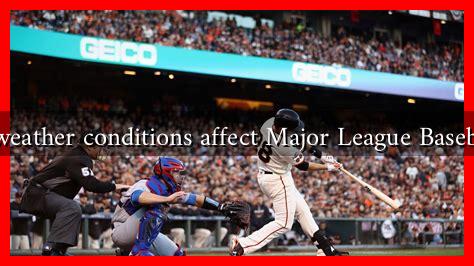-
Table of Contents
How Do Weather Conditions Affect Major League Baseball Games?
Weather conditions play a crucial role in the outcome of Major League Baseball (MLB) games. From temperature and humidity to wind speed and precipitation, various elements can influence player performance, game strategy, and even the final score. Understanding these factors can provide fans, players, and coaches with valuable insights into the game.
The Impact of Temperature
Temperature is one of the most significant weather factors affecting baseball games. It can influence everything from player stamina to the behavior of the baseball itself.
- Player Performance: Higher temperatures can lead to fatigue, affecting players’ endurance and reaction times. Studies have shown that players may perform better in moderate temperatures (around 70°F) compared to extreme heat.
- Ball Behavior: The composition of a baseball changes with temperature.
. In warmer conditions, the ball tends to travel farther due to decreased air density. This phenomenon is often referred to as the “home run weather.” For instance, games played in July and August, when temperatures are typically higher, often see an increase in home runs.
Humidity and Its Effects
Humidity can also significantly impact gameplay. High humidity levels can lead to a heavier ball, which may not travel as far when hit. Conversely, low humidity can make the ball lighter and allow it to fly further.
- Pitching Dynamics: Humidity affects the grip on the baseball. Pitchers may struggle with control in high humidity, leading to more walks and hit batters. A study by the Baseball Prospectus indicated that pitchers’ strikeout rates tend to decrease in humid conditions.
- Field Conditions: High humidity can also affect the field’s condition, making it softer and potentially leading to more injuries. Players may find it challenging to maintain their footing, especially during quick movements.
Wind: A Game Changer
Wind is another critical weather factor that can dramatically alter the dynamics of a baseball game. The direction and speed of the wind can influence how far a ball travels when hit.
- Home Runs and Fly Balls: A strong wind blowing out towards the outfield can turn routine fly balls into home runs. Conversely, a headwind can suppress scoring by keeping balls in the park. For example, Wrigley Field in Chicago is notorious for its wind patterns, which can lead to wildly different scoring outcomes depending on the day.
- Pitching Strategy: Wind can also affect pitching strategies. Pitchers may adjust their approach based on wind conditions, opting for more ground balls when the wind is blowing in.
Precipitation and Game Postponements
Rain and other forms of precipitation can lead to game delays or cancellations, impacting team schedules and player performance.
- Field Conditions: Wet fields can become unplayable, leading to safety concerns for players. MLB has strict guidelines regarding field conditions, and games may be postponed if the field is deemed unsafe.
- Player Readiness: Frequent rain delays can disrupt a player’s rhythm and focus. Players may find it challenging to maintain their mental edge after long waits.
Case Studies: Weather’s Role in Notable Games
Several notable MLB games have been significantly affected by weather conditions:
- Game 5 of the 2017 World Series: Played in Houston, the game was impacted by high humidity and warm temperatures, leading to a record number of home runs.
- Wrigley Field Games: The iconic ballpark has seen numerous games influenced by wind patterns, with some games featuring double-digit home runs due to favorable wind conditions.
Conclusion
Weather conditions are an integral part of Major League Baseball, influencing everything from player performance to game outcomes. Understanding how temperature, humidity, wind, and precipitation affect the game can provide fans and players with a deeper appreciation of the sport. As the saying goes, “It’s a game of inches,” but when it comes to weather, those inches can make all the difference. By keeping an eye on the forecast, fans can better anticipate how weather might shape their favorite teams’ performances.





